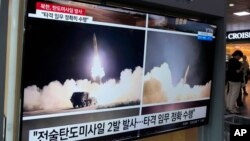North Korea fired an ICBM-class missile Monday with a range capable of reaching anywhere in the United States, a Japanese official said, marking its second missile launch in hours as Pyongyang condemned a U.S.-led show of force as "war" moves.
The ICBM missile has the potential to travel more than 15,000 km, meaning it can reach anywhere in Japan and the mainland United States, Japan's Parliamentary Vice Minister of Defense Shingo Miyake said.
South Korea's National Security Council said it was a solid-fuel intercontinental ballistic missile (ICBM), labelling the launch a destabilizing act that ignored international warnings and multiple U.N. Security Council resolutions.
President Yoon Suk Yeol had ordered the upgrading of the effective operation of "nuclear deterrence" by South Korea and the United States, it said in a statement.
The United States reaffirmed its commitment to the defence of Japan and South Korea after the North's ballistic missile launch, the White House said late on Sunday.
U.S. national security adviser Jake Sullivan spoke with South Korea's National Security Office Director Cho Taeyong and General Akiba Takeo Of Japan and condemned the test, "which is a flagrant violation of multiple U.N. Security Council resolutions," the White House said.
Seoul's Joint Chiefs of Staff said Monday's missile was fired from an area near the capital Pyongyang towards the sea off the North's east coast and flew about 1,000 km.
Japan's defense ministry reported the flight lasted 73 minutes, just short of the 74 minute flight by an ICBM North Korea fired in July. It reached a maximum altitude of more than 6,000 km and fell into the sea west of Hokkaido outside Japan's exclusive economic zone, Japan said.
A missile fired at a lofted trajectory with such an apogee likely means the projectile is capable of reaching 15,000 km on a normal trajectory, according to expert analysis of previous North Korean long-range missile tests.
Such launches underscore the North's efforts to advance its arsenal with longer range weapons that could potentially reach the mainland United States.
The area near the international airport serving Pyongyang is where the North previously launched ICBMs and is suspected to be the location of a missile assembly facility.
The North's latest, solid-fuel Hwasong-18 ICBMs have been launched from near Pyongyang, at a grass field that analysts said is likely reinforced with concrete for the heavy launch vehicle.
Monday's missile launch came after North Korea fired a short-range ballistic missile on Sunday night, flying about 570 km and falling into the ocean.
North Korea followed up that launch with a fiery statement condemning the United States for orchestrating what it called a "preview of a nuclear war," including the arrival of a nuclear-powered submarine in South Korea on Sunday.
U.S. submarine visits South Korea
In the conversation with his South Korean and Japanese counterparts Sullivan stressed the importance of sharing missile warning data, the White House said.
The three allies have been working to set up a real-time missile data sharing system, but it is still "a few days" from going operational, South Korea's defence ministry said.
On Friday, following a high-level meeting by U.S. and South Korean officials on the use of U.S. strategic military weapons to deter North Korea's military threat, Washington warned any nuclear attack would lead to the end of the regime.
South Korea condemned the latest missile launches as a violation of U.N. Security Council resolutions that ban the use of ballistic missile technology, which Pyongyang rejects as an infringement of its right to self defence.
The U.S. State Department also condemned the launch and urged Pyongyang to get back to diplomacy and dialogue.
After the late-night launch, North Korea's defence ministry criticized "military gangsters" in the United States and South Korea for raising tensions with drills, displays of force, and nuclear war planning.
The statement by an unnamed ministry spokesman cited the arrival of the U.S. nuclear-powered submarine Missouri in the South Korean port city of Busan on Sunday.
Visits by U.S. nuclear submarines had previously been rare, but they have increased under agreements between Seoul and Washington that have boosted the arrivals of U.S. military assets.
The USS Carl Vinson, a U.S. aircraft carrier, also arrived at Busan last month as part of an effort to increase deterrence against North Korea's nuclear and missile programs.
The North Korean defence ministry also condemned the meeting by South Korean and U.S. officials in Washington as yet another sign of efforts to streamline war preparations and a provocative show of force.
The United States and South Korea have increased the intensity of joint military drills against rising threats from the North, which had tested a range of ballistic missiles and in November launched its first military spy satellite.









